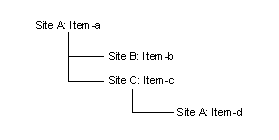This topic applies only to APS.
In single-site mode, APS Planning regenerates the plan only at the local site. In global mode, APS Planning regenerates all plans, transfer supply orders, and transfer demand orders at all sites defined on the APS Sites and Alternative Management form. The sequence in which each site is planned is determined by the site priority defined at the local site where you run APS Planning.
When you run APS Planning in global mode, APS performs these steps:
During global APS Planning, or during any incremental planning activity, if an item requires a component that is supplied by another site (that is, an "inter-site" transfer), the system plans transfer orders as follows:
NOTE: Due dates on planned transfer orders include transit time.
If APS Planning is unable to contact the supply site (due to the site's planner database being down, network problems, etc.), it uses the item's lead time and the transit time defined on the Inter-Site Parameters form to determine the projected availability of any remote components.
Transfer orders can automatically generate additional remote orders, depending on the component's requirements. For example, if site A needs a component that is produced at site B, and the component at site B requires a component produced at site C, the APS Planning plans the demand transfer order at site C automatically.
NOTE: The system globally plans intra-site transfers for dedicated-inventory warehouses that are set to plan intra-site transfers. Transit time also must be specified.
Once a transfer supply order is generated by a demand order, no other demand order can use inventory created by the transfer supply order. However, any excess inventory generated due to minimum lot sizes remains available at the supply site for other demands to allocate.
APS Planning creates planned transfer orders; you must firm them into actual transfer orders using the Planning Detail form, Material Planner Workbench form, or Intra-Site Transfer Detail Firm Transfer Order form.
The system does not support site-to-site recursion on a single order line. That is, an item at one site cannot require a component from a site that was a supply site higher in the item's bill of material. The following example illustrates site recursion:

In this example, item-d is made at Site A, which is already specified in a parent node in the BOM (therefore, the system has already run the plan at Site A). In this situation, the system does NOT plan item-d at Site A. Instead, it creates a planned order for item-d using the standard lead time for that item.
On the Demand Detail Chart APS form, this planned order is accompanied by the label "Site Recursion - Use New Supply."
On the Planning Detail form, this planned order is accompanied by the exception message "Site Recursion - Lead Time Used." You should firm these planned orders into transfer orders.
For any supply sites not defined on the Planning Parameters form, you must set up replication rules to allow the supply site to "see" any demands coming from the site that initiated APS Planning. For more information, see Setting Up Planned Transfer Order Replication.